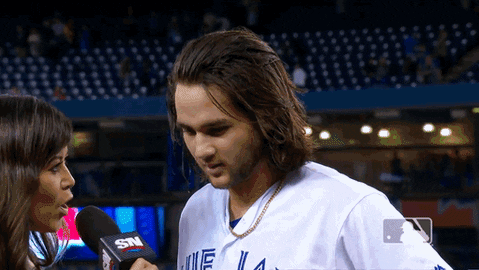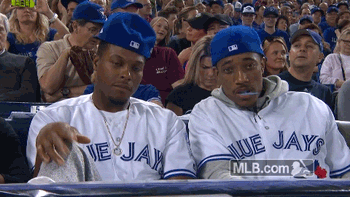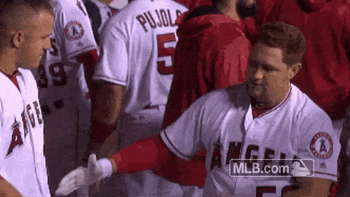
Top of the inning
Each team gets a chance to bat (hit the ball), and a chance to field (play defense). The top of the inning is when the visiting team is up to bat.
Bottom of the inning
...and the bottom of the inning is when the home team is up to bat.
Runs
A run is scored when a player makes it all the way around the diamond (first base, second base, third base and back to home plate where they started).
Extra innings
There are nine innings (where each team gets a turn to bat and a turn to field) in a baseball game. If it’s tied at the end of the nine innings, they play more innings until there is a winner.
Up to bat
A player's turn to hit the ball.
ERA
Stands for ‘earned runs average’ and is used to determine how effective a pitcher is. Basically, you count up the amount of runs a pitcher allows per inning, and average that amount out over the nine innings. The lower the better.
RBI
Stands for ‘runs batted in’. An RBI occurs when you or one of your teammates who is already on base comes around to score a run. For example, Lisa is up to bat and hits a home run while her teammates Linda and Lucy are on first and third. Lisa scores three RBI.
RBI count even if you get out! Like by using a SAC fly (see below) to help get your teammates home.
Outs
To end an inning, a team must get three players “out.” You get people out by catching the ball before it bounces, by touching the base or player before they can make it to a base, or when the pitcher throws three strikes.
Double play
Getting two players out on the same play. You’ll hear commentators say “inning ending 6, 4, 3 double play.” In this instance, it means the baseball was hit to the shortstop, who threw it to the second baseman, who stepped on the base to get the runner from first to second out. Then, the second baseman threw it to the first baseman who has his foot on the bag (base) to get the runner from home to first out. Click here for a visual of the numbers in correlation with the positions in baseball.
SAC fly
SAC is short for SACrifice. This means that the person at bat literally “sacrifices” themselves for the good of the team by hitting the ball as high and as far away from the infield as they can so that their teammate can advance. Once the ball is caught, the teammate can tag up (see below) and run to the next. So the farther away the ball is hit, the better!
Pop fly
Contrary to a SAC fly, a pop fly is by accident. Whoops. It’s when the ball is hit or "popped" high into the air and the fielder catches it.
Tag up
After a SAC or pop fly, a player can run BUT they must tag up to the base they’re on first. This means they have to wait until the ball is caught, touch their base (just with the foot is okay) and then sprint their lil’ hearts out to the next base.
Strike zone
The strike zone is anywhere over home plate and between the knees and the middle of the torso. When a pitcher throws a ball through this area and it isn’t hit, it’s called a strike by an umpire standing behind the catcher. Did we mention these balls can travel over 100 mph? That's speed, baby.
Umpires
AKA umps, who act as referees and keep things in line. One stands behind the catcher calling all the balls, strikes, fouls and outs. Three supporting umps usually stand at each base, but it can be up to six total in important games.
Strike
SSTTTTEEE-RIKE! This is when a player doesn’t swing at the ball when it’s in the strike zone, when a player swings at the ball but misses, or when they hit a ball foul (only for the first and second strikes). And remember “for it’s one, two, three strikes you’re out at the ollllll’ balllll game.”
Ball
When the pitcher throws the pitch outside of the strike zone and the player doesn’t hit it. If the pitcher throws four balls, the batter automatically gets to go to first base. This is called a walk.
Foul
If a ball gets hit outside the field of play. Think of the field like a big triangle, with the top of the point being home plate. If the ball travels too far to the left or right, it will be considered a foul. Remember though, a ball can still be caught in foul territory (the area outside of the triangle) to get a player out.
Single
When the player hits the ball and is able to run to first base before the ball gets there. See, being single isn’t so bad!
Double
Similar to above, a double is when the player hits the ball and is able to bust their chops to pass first base and get all the way to second. A double is also awarded when the ball bounces and then goes over the back wall in the outfield. This is called a ground-ruled double.
Triple
A triple is a rarity on the diamond. This happens when the player hits the ball and runs three bases. This player will also henceforth be called Speedy McSpeederton.
Home run
A home run usually happens when a player hits the ball out of the park. This means they hit it beyond the wall/fence/marking of the diamond. On very special occasions, there are in the park home runs, meaning the ball doesn’t leave the playing field but the batter still manages to make it all the way around the diamond. These normally happen because of errors made by the fielding team.
Walk off
Okay so picture this: things are all tied up in the bottom of the ninth inning. You’re super nervous heading up to bat, because you know you represent the winning run. You absolutely smash the baseball and get a hit, home run or grand slam and are able to win the game! A “walk off” is basically the term used to describe that final action to win the game, so that you can ‘walk off’ the field and into the clubhouse to celebrate. Get it?
Errors
A fielding player dun goofed and cost their team a base or run.
IP
Innings pitched. Another v. simple acronym.
Bullpen
No bulls here! This is just the area where pitchers warm-up before entering a game. Pitchers are either starters (self-explanatory), relievers (they come into the game when the starter gets tired or is having a bad game) or closers (they generally only play one or two innings at the end of the game to “close” out a win).
Reliever
Relievers are the pitchers who enter the game to "relieve" the starting pitcher, either when the starter is getting tired or pitching poorly.
Closer
Closers are the pitchers who typically only throw one or two innings to "close out" the game. Closers are known for often facing high pressure situations...and having some of the best entrance songs as they head out to the mound.
Steal
This is when a player is super sneaky and runs from first to second, second to third or third to home (though, this is very rare) behind the pitcher's back. A player has to be exceptionally fast to get to the next base without getting thrown out. A steal is also finding anything at Club Monaco for under $50.

Balk
When a pitcher pretends like she’s going to pitch but then goes “JK don’t feel like it” and stops her pitching motion. If the ump determines it’s a balk every player gets to advance one base.
Challenge
When the coach/general managers (GMs) don’t agree with a play on the field they can call a challenge. They get one challenge over the first six innings, and then two from the seventh inning until the end of the game. There are some MLB employees in an office in NYC that review the video with the ump and help decide what the call should be. Ruling on the field stands if there’s not enough evidence to change it.
Ejected
Sometimes coaches, GMs and players get fired up after what they think the ump makes a poor call. It’s not uncommon to see staff or players get all up in an ump’s face to dispute a call and then see them get tossed from the game. This can also happen when players brawl. Sayonara!
Batting average
Take a player’s number of hits and divide it by their number of at-bats. The higher the batting average, the better. It is usually reported to three decimal places and read without the decimal. For example, a player with a batting average of .300 is "batting three-hundred” and anything over .300 is considered to be v. good.
Dingers
Slang term for a home run. “He hit three dingers last night and won the game!”
Field
“To field” the ball or “fielding” the ball just means that you’re the team playing defense since, you know, you’re out in the field and all.
Infield
The area of the field from the base-path inwards. If you picture a baseball diamond, the infield is the centre sandy part with the pitching mound in the middle.
Outfield
Beyond the infield diamond. The three players in the outfield are responsible for catching those long balls and for throwing the ball back to the infield as fast as humanly possible.
Seventh inning stretch
A sweet little point in the game in between the top and the bottom of the seventh inning where you literally get to have a stretch. The entire stadium generally sings the classic “Take Me Out to the Ball Game.”
Softball
Softball is basically a modified form of baseball. It’s played on a smaller field and over only seven innings, but with a bigger ball and the pitcher throws underhand.
Fastpitch
Softball where the pitch is thrown with some nice HEAT because the pitcher spins their arm around like a windmill. Vroom, vroom.
Slow pitch
Instead of throwing a pitch fast you throw it nice and slllooooowwwww with an arc three to 10 feet high.
Enjoying this article? Want more?

Sign up for The GIST and receive the latest sports news straight to your inbox three times a week.


